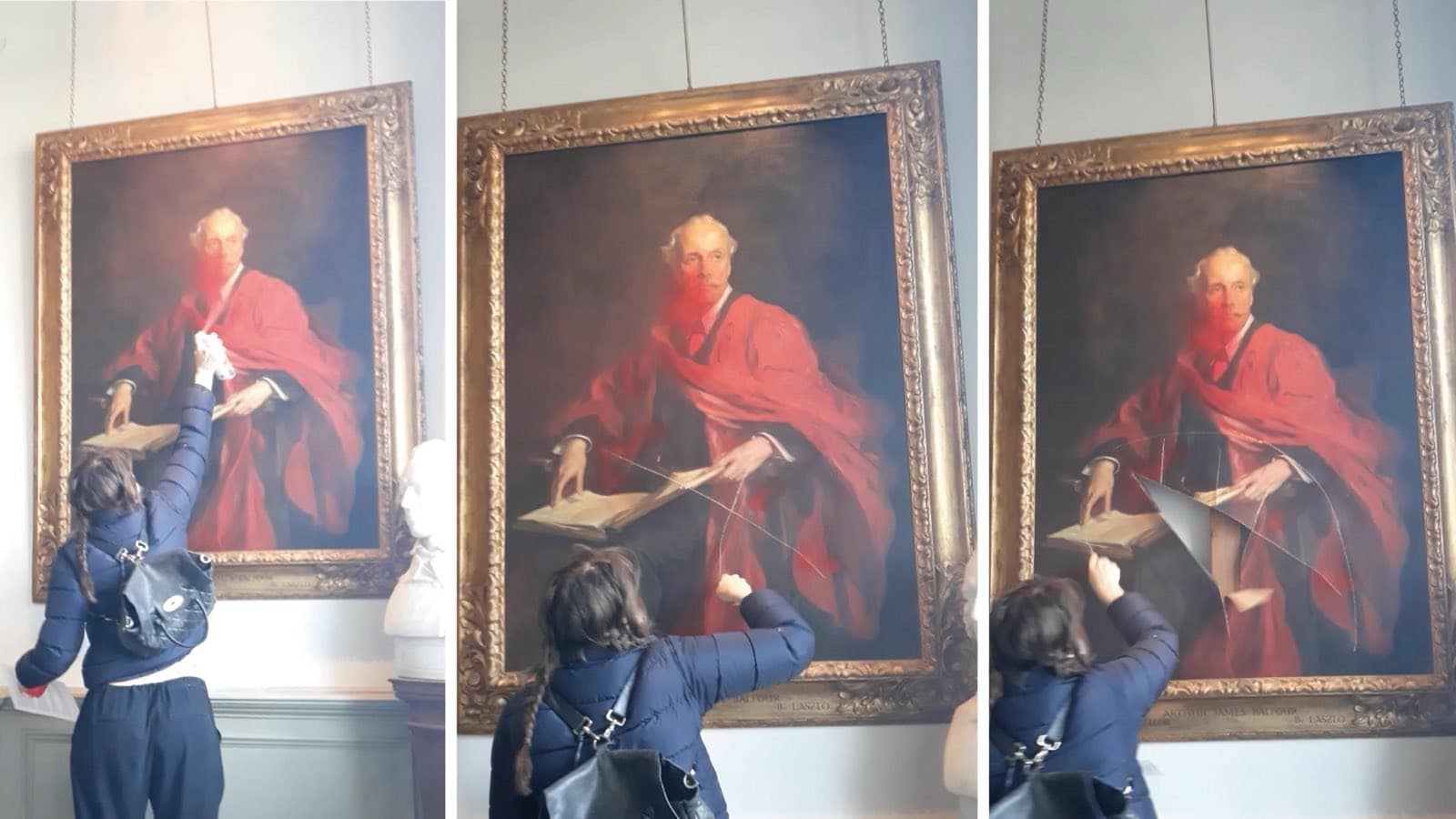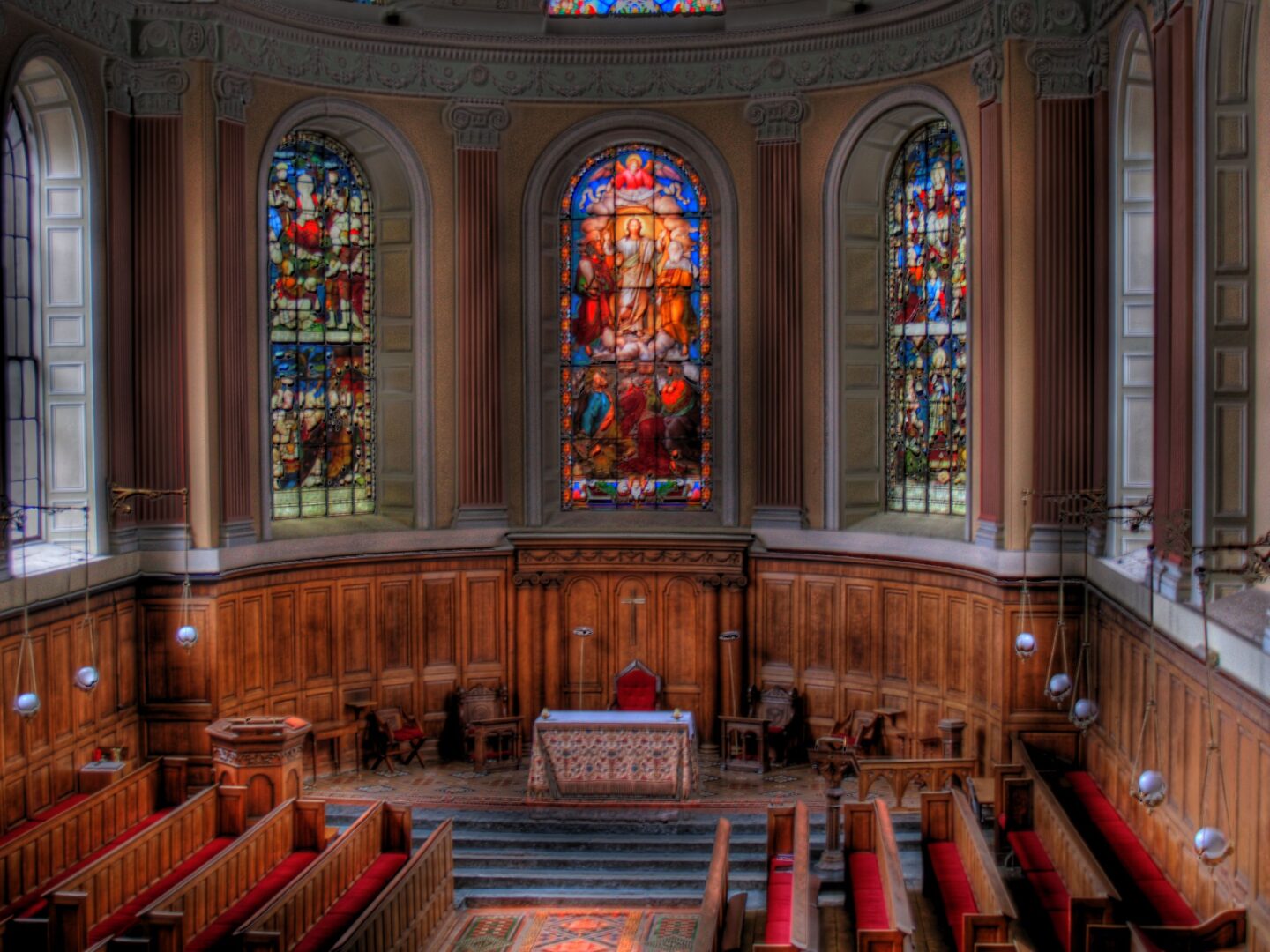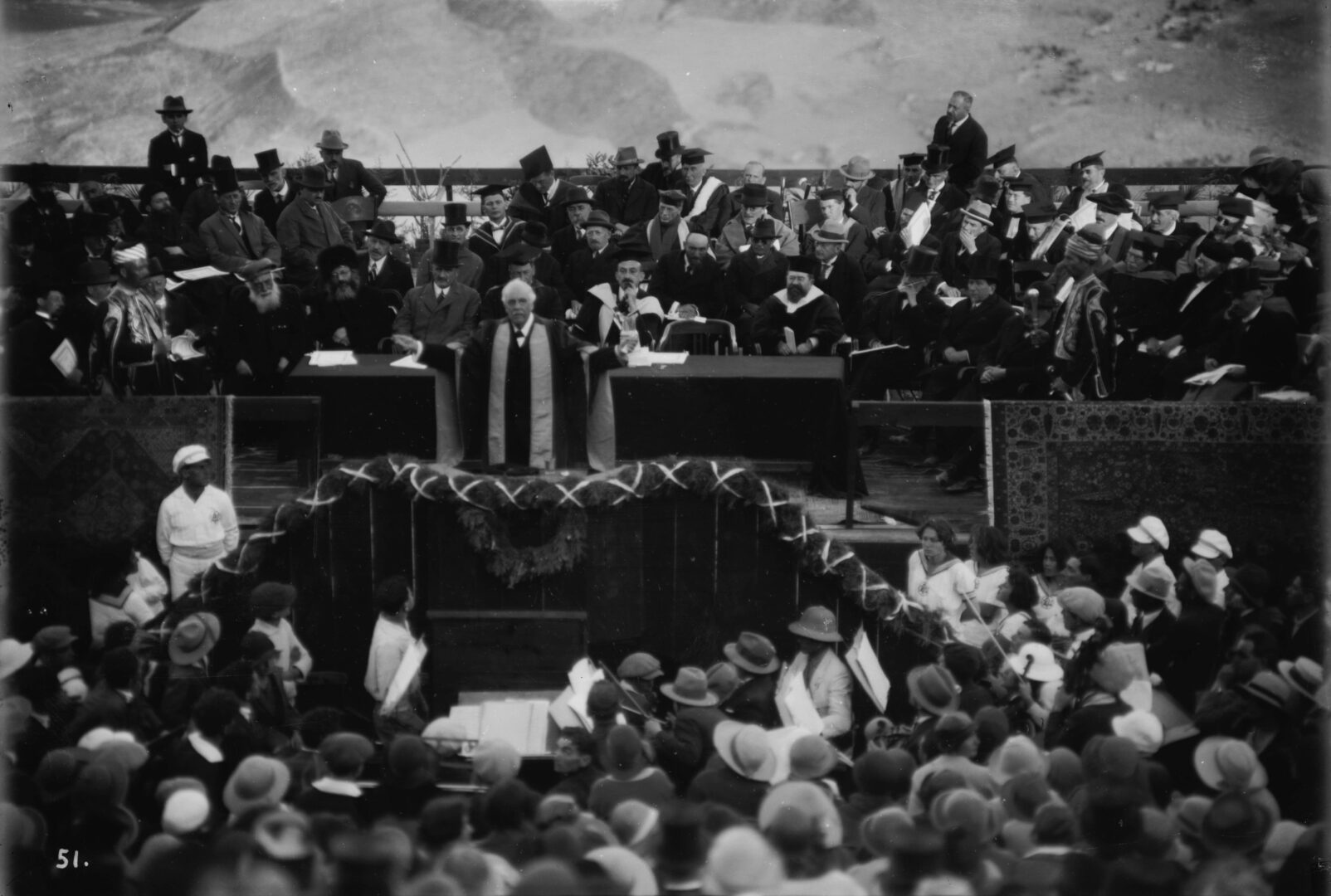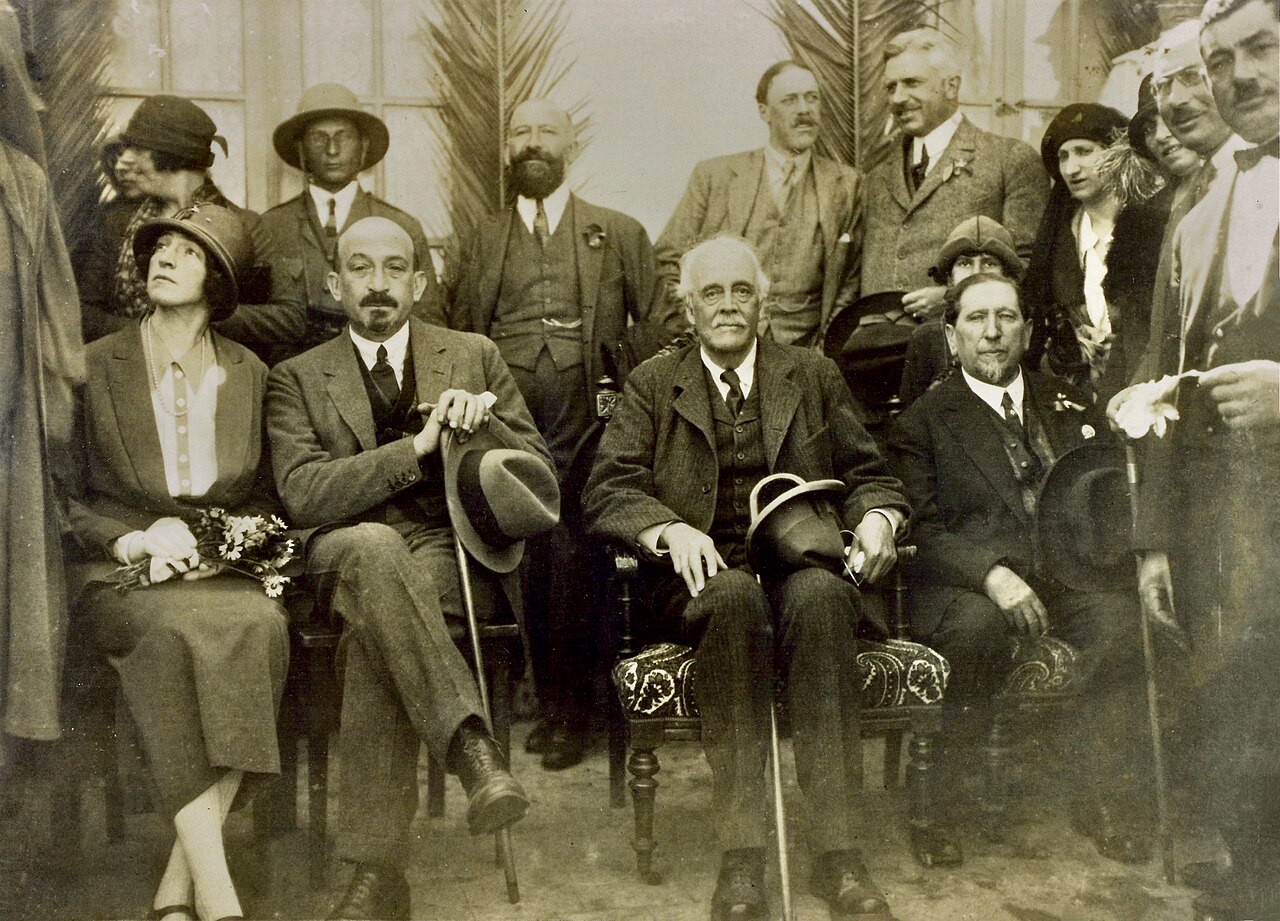On 8 March 2024, the conflict in Gaza claimed an unlikely victim: the portrait of long-dead British statesman Arthur Balfour which hangs in Trinity College, Cambridge. No sooner was the painting of Balfour attacked and defaced by a pro-Palestinian activist than predictable battle lines were being drawn online. For some, this was a symbolic blow struck for freedom, and against British and Israeli colonialism. For others, it was another shameful sign that antisemitic extremism is taking over UK campuses. The most important context to these arguments is naturally the all-too-contemporary tragedy playing out in the Middle East. Nonetheless, for those seeking additional historical background for this act of targeted vandalism, it is worth taking a moment to consider the perspective of someone who had quite a lot to say about empire and sectarian strife in a university context. This is none other than Arthur Balfour himself.
It is also worth considering what, if any, significance the University of Cambridge has to Balfour’s controversial legacy. At first glance, this is largely tangential; his portrait hangs in Trinity because he was a famous alumnus, but he left its halls several decades before the events to which today’s activists object.
Chief among these was the Balfour Declaration of 1917, whereby – in his capacity as Foreign Secretary within the UK’s wartime government – he expressed the first official support for the creation of a Jewish “national home” in what was shortly to become the British-ruled Palestinian Mandate. The declaration’s negative consequences for the Arab population form the bulk of Palestine Action’s published justification for their attack on his portrait, and Trinity and Cambridge are not mentioned other than as locations where the picture happened to hang.[1]
Nonetheless, Cambridge was more than just a dimly remembered alma mater to Balfour. It shaped his identity as a politician, and it formed the blueprint for a project to which he repeatedly returned: that of transcending inter-community conflict through the power of academia.

Creating a Catholic Cambridge in Ireland
Balfour’s relationship with Cambridge began in the late 1860s on rather undistinguished terms. As an undergraduate, he preferred to rely on his own intelligence rather than rigorous study, and consequently fell short of a First in his final exams. Yet he had an aristocrat’s instinct for building networks, and the contacts he made on campus – including the great academic reformer (and namesake of the Sidgwick Site) Henry Sidgwick, and the future Nobel-winner John Strutt, each of whom ended up marrying one of his sisters – influenced his subsequent development into a public intellectual. Cambridge University served as a site for fostering intellectual and political networks – a theme we discuss in debth on our Original Uncomfortable Cambridge tour of the city.
His A Defence of Philosophic Doubt was published in 1879, and (along with his well-regarded later work, The Foundations) reflected a lifelong interest in trying to reconcile scientific progress with theistic and humanistic tradition. Meanwhile, his formidable family connections also offered easy inroads into the less highbrow world of politics; his uncle, Lord Salisbury, was a three-time Conservative Prime Minister, who secured his nephew’s entry into Parliament and first major ministerial post as Chief Secretary for Ireland. Here, Balfour’s adopted identity as a gentleman-scholar was to play a role in how he ruled over Britain’s oldest colony.
As a fierce champion of Unionist orthodoxy, much of Balfour’s tenure was spent seeking to crush anti-British agitation in Parliament and on the streets, and his defence of the Royal Irish Constabulary’s “Mitchelstown Massacre” of 1887 earned him the nickname “Bloody Balfour” among his opponents. However, he sought to conciliate Catholic sentiment in some matters, and not least of these was university policy. For some years, Irish Catholics had been seeking to establish higher education institutions as a counterweight to Dublin’s own (Protestant-dominated) Trinity College, but this met with resistance from many Unionists, who argued that any new foundations would have to be strictly religiously neutral or else would promote sectarian division. For his part, Balfour increasingly came round to the view there was no danger in having a de facto Catholic university, provided that non-Catholics were not formally excluded. His rosy view of Cambridge – where a loose Anglican hegemony coexisted with tolerance for minorities of other faiths – clearly formed part of the model for this. As he put it, “the essence of my plan was to create a University which, so far as its constitution was concerned, would be as unsectarian as Oxford or Cambridge or Trinity College, Dublin, but which should have a governing body as distinctly Roman in its general complexion as the governing body of those other Universities is Protestant.”[2] In the long run, he believed that creating an Oxbridge-style environment for educated Catholics would wean them from the influence of their Church and foster a more scientific mindset that was amenable to British rule.[3]

Balfour’s scheme evolved over several years after he moved on from the Ireland brief to higher offices, including – from 1902 onwards – that of Prime Minister. Yet for all his efforts, his vision of a segregated yet harmonious Irish university system foundered on harsh political realities. Wrangling over the exact nature of the reforms and hardening objections from Unionists stalled legislation for years, and the plan remained in limbo when the Tories were swept from power in 1906. It was left to the ensuing Liberal government to enact a version of his project, reorganising several pre-existing institutions into the Catholic-leaning National University of Ireland and the Protestant-leaning Queen’s University of Belfast. By this point, decades of division and delay had eaten away at any goodwill this might have earned Britain among Irish nationalists, and the new foundations largely played into deepening faultlines that were making co-existence impossible. More educational opportunities were not enough to blind Ireland’s Catholics to the increasingly militant Unionism which Balfour had fostered through his other actions, and within a few years the island was to splinter into rebellion and civil war.
The chancellor goes to Jerusalem
The events surrounding the issue of the Balfour Declaration have been dissected and debated many times, and it is not possible to do them justice here. It is perhaps significant to note, however, that Balfour’s involvement in Palestine’s affairs did not end after he left the great offices of state, and on at least one occasion intersected with his renewed association with the University of Cambridge. In 1919, the university was in need of a chancellor, and his status as a semi-retired statesman with an intellectual reputation recommended him for the job. As its ceremonial head, he was active in various projects such as fundraising for the University Library (which perhaps stands as a far more imposing monument to his influence than Trinity’s damaged portrait). It was also as a kind of ambassador for the university that he was to make his first and only visit to the land he had reshaped with his pen.
Having secured Britain’s vague commitment to the creation of a Jewish refuge in Palestine, the energies of the Zionist movement had increasingly turned to various projects aimed at giving this idea institutional substance, among which was founding establishments of higher learning. Thus, on 1 April 1925, Balfour stepped onto a podium on Mount Scopus, just outside Jerusalem, as the guest of honour at the Hebrew University’s formal inauguration. He was dressed in the formal robes of a Cambridge chancellor, symbolically bestowing the blessing of his ancient university upon the new one rising from the soil.[4]

Balfour’s speech on that day gives some indication of why the project had inspired him to make the long journey. Once again, he drew upon a familiar model of academia as a vector for civilising compromise, declaring that “we are now engaged in adapting Western methods and the Western form of the university to an Eastern site, and it is education which is to be in an Eastern language that is the new experiment.”[5] This last aspect was a point of particular sensitivity. After much debate, it had been decided that the language of instruction in Palestine’s new universities should be Hebrew, and Balfour addressed the challenges of reviving an ancient liturgical language as a medium for modern technical education; despite noting the “great difference between Isaiah and microbiology,” he claimed that the experiment was bound to succeed. No doubt this ambitious attempt to reconcile Abrahamic tradition with scientific progress appealed to his own scholarly interests, but it came at a heavy price. The losing side in the debate had proposed that teaching also take place in German and Arabic, and without the latter language there was little chance that non-Jewish residents of the region would be able to attend the new foundation.
Nonetheless, Balfour concluded his speech by painting a picture of another kind of reconciliation. Citing the collaboration of Middle Eastern scholars to preserve classical learning during the West’s dark ages, he asked “if, in the tenth century… the Jews and Arabs could work together for the illumination of Europe, cannot Jews and Arabs work now in cooperation with Europe and make this not merely a Palestinian university, but a Palestinian university from which all sections of the population of Palestine may draw intellectual and spiritual advantage?” As in Ireland, it appears he saw no contradiction in founding a university dominated by one religious community in order to foster peace for all.

There remains something appealing in Balfour’s long-held and genuine belief in the power of scholarship to overcome sectarian differences. Yet, also as in Ireland, it was coupled with a wilful blindness to the real circumstances surrounding his fondly imagined ivory towers, which ultimately made a mockery of his peaceful rhetoric. He made little effort to understand the real grievances of Palestinian Arabs, despite his visit being greeted by strikes, written protests and press campaigns. Their concerns about being displaced were viewed as minor next to the imperative that – as another member of the academic delegation put it – “some friendly and reliable people must control Palestine” and its strategic approaches to the Suez Canal.[6] The dangers inherent in his disconnect from reality were made abundantly clear when, a few days after the inauguration, Balfour made a sightseeing excursion into Syria with the object of viewing the Roman ruins at Baalbec, only for an angry crowd to storm his hotel in Damascus. The authorities responded by firing upon the rioters, killing three in a grim echo of the Mitchelstown Massacre decades before.
Balfour was duly whisked off to a waiting steamer in Beirut, but the problems he left behind were not so easily spirited away; one British official fretted that “his visit has put the clock of reconciliation back by at least a year,” and arguably it has only been moving backwards ever since.[7] The Hebrew University unsurprisingly turned out to be a considerable success as an academic institution, and a complete failure as a symbol of cross-community collaboration. This was bloodily emphasised in 1948 following the collapse of Britain’s mandate, when Arab fighters assaulted a medical convoy en route to Mount Scopus and laid siege to the campus, claiming that the university hospital was a Jewish paramilitary base; another grim echo, and this time one that resonates forward into the present.
Conclusion
This reminder of recent violence drives home that, ultimately, the personal views of one politician and the fate of his attacked portrait fade into insignificance next to a conflict which has already obliterated multiple universities and tens of thousands of human lives. Nontheless, the attack on the Balfour painting in Cambridge reminds us that Cambridge’s entanglement in Balfour’s failed projects for peace – however small – goes beyond merely providing a wall on which to hang his picture. In a sense, this entanglement continues, for in the long run Balfour’s vision has backfired; instead of creating colonial Cambridges which could foster tolerance on terms favourable to Britain, his legacy has resulted in sectarian tensions from abroad taking root in his old university. Cambridge may no longer be able to reshape Palestine, but Palestine may still reshape Cambridge.
Written by Louis Morris
Learn More
Read more on the history of Catholicism and conflict in our blog post Toppling Statues: An Oxford Tradition.
Interested in more Irish History? Our podcast has a special episode on the Irish Freedom fighter Roger Casement. You can also read more about Irish Nationalist and controversial figure Sir Michael O’Dwyer on our blog about his legacy.
References
[1] ‘Palestine Action slash painting of Lord Balfour in the University of Cambridge’, Palestine Action (8 March 2024). It has been suggested that Trinity was targeted specifically because of its continued investment in Israeli armaments firm Elbit Systems, but if so, the activists chose to omit this from their public manifesto; while their statement specifically demands that Elbit be shut down, it nowhere brings up Trinity’s connection. See Imran Mulla, ‘Activist defaces Balfour portrait in Cambridge college investing in Israeli arms company’, Middle East Eye (9 March 2024).
[2] Balfour Letter of 8 June 1899, quoted in Robert Stephen Gibson, Balfour and Education 1896-1911 (PhD Thesis, University of Liverpool 1992), p. 106 n115.
[3] Catherine Shannon, Arthur Balfour and the Irish Question 1874-1921 (PhD Thesis, University of Massachusetts Amherst 1974), pp. 92-3.
[4] For an account of the visit and the ceremony, see Roy Macleod, ‘Balfour’s mission to Palestine: science, strategy, and the inauguration of the Hebrew University in Jerusalem’ in Minerva 46 (2008), pp. 53-76.
[5] ‘Balfour dedicates Hebrew University: Urges Arabs to cooperate’, New York Times (2 April 1925).
[6] E Guthrie Perry, ‘A Hebrew University in Jerusalem’, Dalhousie Review (1925), p. 387.
[7] Quoted in William Matthew, ‘Balfour in the Levant, Spring 1935’, Balfour Project.





